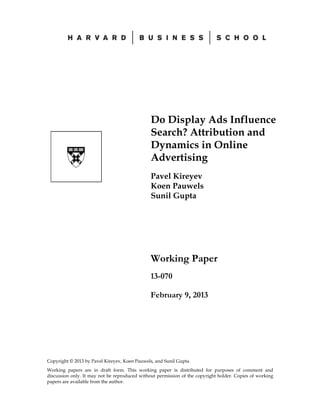
Do Display Ads Influence Search? Attribution and Dynamics
- 1. Do Display Ads Influence Search? Attribution and Dynamics in Online Advertising Pavel Kireyev Koen Pauwels Sunil Gupta Working Paper 13-070 February 9, 2013 Copyright © 2013 by Pavel Kireyev, Koen Pauwels, and Sunil Gupta Working papers are in draft form. This working paper is distributed for purposes of comment and discussion only. It may not be reproduced without permission of the copyright holder. Copies of working papers are available from the author.
- 13. interdependencies depicted in Figure 3 points to the appropriateness of using a flexible approach, such as persistence modeling, to capture cross‐ad spillovers and online advertising dynamics. Figure 3: Granger‐causality graph SA DA SC DI SI We conduct Augmented Dickey‐Fuller (ADF) and Kwiatkowski‐Phillips‐Schmidt‐Shin (KPSS) unit root tests to determine if the endogenous variables are evolving or stationary. Table 3 summarizes the resulting statistics of the unit root tests. The KPSS test identifies all series as evolving, whereas the ADF test identifies all but as evolving. We choose to include as an evolving variable following the outcome of the KPSS test to allow for richer cointegration possibilities. Table 3: Summary of unit root test results TestVariable SA DA SI SC DI ADF ‐2.006 ‐0.428 ‐4.444 ‐2.657 ‐1.984 KPSS 0.872 0.874 0.813 0.587 0.850 Note: Bold numbers indicate significant evidence of non‐stationarity 11
- 14. The Johansen cointegration trace test identifies three cointegrating relations. These relations can be interpreted as long‐run equilibrium conditions which may arise as a result of firm budgeting rules or consumer decision processes. Based on the outcomes of the Granger causality, unit root and cointegration tests, we specify a vector error correction model (VEC) with all variables as endogenous. The interpretation of VEC models is particularly interesting from a substantive perspective. Both managers and researchers may expect a long‐term equilibrium linking search and display applications to a combination of firm control variables (e.g. search and display ad impressions) and consumer actions (e.g. clicks on these ads). Economist Walter Enders states that economic theory abounds with equilibrium theories which, if they involve non‐stationary variables, “require the existence of a combination of the variables that is stationary” (2010, p.356). Within marketing, researchers often voice opinions about the necessary intricate relation between firm activity, consumer activity, and purchase action. Error correction models have been used to study the long‐run impact of a product harm crisis (Van Heerde et al 2007), market share cannibalization by new innovations (Van Heerde et al 2010), and long run sales sensitivity to price changes (Fok et al 2006). The general form of the VEC model with lags is given by equation 1, Δ Δ (1) , ~ , 0, , In equation (1), is the vector of endogenous variables at time , and are vectors of deterministic components (e.g. intercept, trend), is a matrix of cointegrating relations, , , … , , and are parameter matrices to be estimated, and is the covariance matrix of the multivariate‐normally distributed error terms . The coefficients in ,…, capture the effects of past changes in the endogenous variables on their current deviations. The coefficients in reflect the speed of adjustment of the endogenous variables towards the equilibrium cointegrating relations defined in 12 . We refine the model further by
- 15. allowing for an intercept in both and . The intercept in the model specification allows for the possibility of a deterministic time trend to exist concurrently with the stochastic one implied by the error correction model. The intercept term in the cointegrating vector is included to account for the initial values of the endogenous variables. The Bayesian Information Criterion identifies a lag‐length of 1 as optimal. The resulting model specification is indicated in equation (2): Δ Δ Δ Δ Δ Δ Δ Δ Δ Δ 1 1 0 0 0 1 0 0 0 1 (2) , , , , , The parameters are recovered in two steps. First, Johansen’s procedure is used to estimate the cointegrating vectors. Then, the first differences of the endogenous variables are regressed on an intercept, their lags and the cointegrating vectors to recover the remainder of the coefficients. Not all the coefficients in this model are identified. In particular standard errors cannot be recovered for , and . Furthermore, an arbitrary normalization is required to identify the remaining coefficients of the matrix. Table 4 summarizes the full set of parameter estimates and asymptotic standard errors. The model exhibits good fit for a model in differences, with individual equation statistics ranging from 0.27 to 0.45. Portmaneau tests fail to find significant evidence of residual autocorrelation and normality tests fail to reject normality of the residuals. Furthermore, generalized fluctuation tests for structural change fail to find significant evidence of parameter instability. 13
- 16. Table 4: VEC parameter estimates (asymptotic t‐statistics in parentheses) Cointegrating Eq: , , 1.000000 0.000000 0.000000 0.000000 1.000000 0.000000 0.000000 0.000000 1.000000 -0.026943 [-6.19270] 0.001345 [ 0.58142] -17.58090 [-5.00585] 1.77E-06 [ 0.51097] -2.14E-05 [-11.6546] -0.009488 [-3.39954] 109.1041 -26.13430 5200.822 Error Correction: Δ , Δ Δ Δ Δ , -0.091170 [-1.52498] -0.175613 [-2.74302] 79.30134 [ 0.66615] 5.523423 [ 0.89771] 7495.433 [ 1.21460] , -0.107651 [-1.01232] -0.139443 [-1.22448] -429.4406 [-2.02803] -29.77596 [-2.72068] 32198.84 [ 2.93331] -0.000157 [-2.85132] 0.000195 [ 3.31444] -0.402342 [-3.67005] 0.002561 [ 0.45207] 3.103370 [ 0.54608] , Δ -0.443194 [-2.78235] -0.138795 [-0.81368] -721.8211 [-2.27574] -3.728723 [-0.22745] -7399.273 [-0.45002] Δ 0.234133 [ 1.90658] -0.433164 [-3.29385] 87.36913 [ 0.35729] -2.568378 [-0.20322] -11868.29 [-0.93627] Δ 0.000189 [ 2.63937] -4.02E-05 [-0.52406] 0.327024 [ 2.29089] -0.014157 [-1.91883] 1.069115 [ 0.14448] Δ -0.002645 [-1.62591] -0.000102 [-0.05828] -4.195442 [-1.29520] -0.127549 [-0.76186] 249.0512 [ 1.48318] -3.72E-06 [-2.05150] 5.22E-06 [ 2.68708] -0.009798 [-2.71173] -0.000447 [-2.39148] 0.144877 [ 0.77352] -1.594333 [-0.45454] -6.117405 [-1.62862] -7426.962 [-1.06336] -356.0680 [-0.98637] -249869.3 [-0.69013] 0.396648 0.381397 0.453215 0.370934 0.266994 Δ It is difficult to directly interpret the parameters of persistence models, so we proceed to derive implications by impulse response analysis. 14
